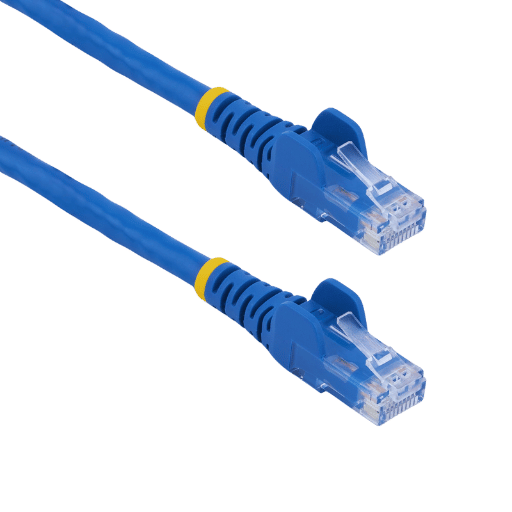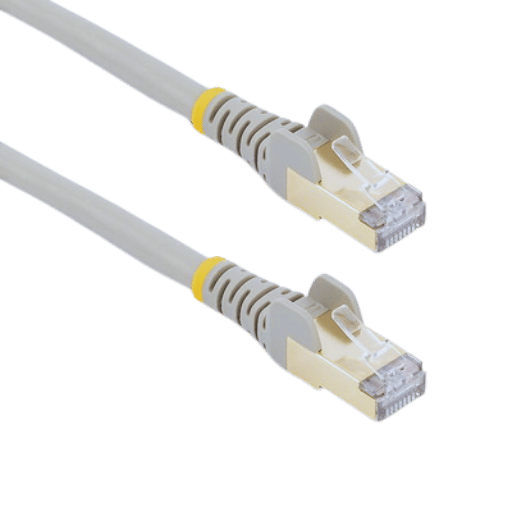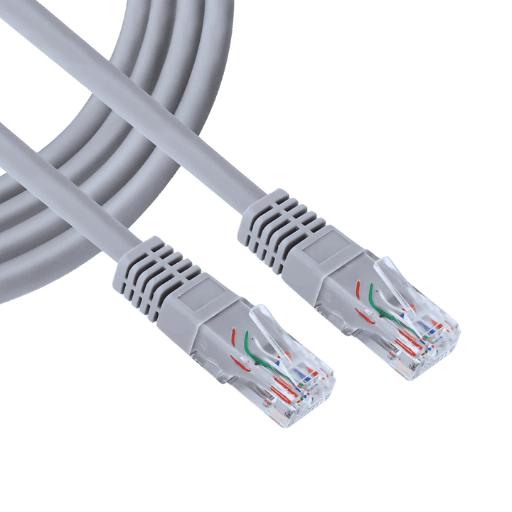The desire for reliable solutions for networking and connecting bandwidth and data expansion is more critical in the current climate, considering the advancement of the digital ecosystem. Ethernet is instrumental in maintaining smooth internet connections as well as transmitting data which is critical in the modern day regardless of whether it’s for personal or business use. This article seeks to explore the remarkable qualities of the 6ft Ethernet cable as well as the technical parameters that guarantee its simplicity, ease of use, and exceptional performance across a host of networking situations. These include setting up the home office, enhancing the gaming experience, or managing a complex business structure, along with understanding the features of the Ethernet networking tool in order to increase the effectiveness and connectivity of the structure in question.

The 6ft Ethernet cable conforms to the Cat 6 standard, which allows data rates of up to 1 Gbps over a distance of not more than 55 meters. It is equipped with 24 AWG copper conductors and RJ45 connectors with gold plating, which improves conductivity while minimizing interference. The cable has a construction of twisted pairs with a protective outer cover for added strength and reduced signal attenuation. It can be used with a number of devices such as PCs, routers, switches, and gaming consoles, making it an all-around solution for home and office networks.
The intended use of an Ethernet cable is greatly correlated with its length with the 6ft variation being the most common. A 6-ft Ethernet cable is ideal for most devices in the household or office as it allows for the connecting of devices without having any excess wire. One of the clear technological advantages of this length is that it has the potential for optimal signal range and weakness when used within this range.
When it comes to advantages, a 6ft Ethernet cable has many. Its size allows for less bulk as well as it is a safer option as the chances of someone tripping on the wire are rather diminished, making it ideal for workstations or entertainment stations. Also, reducing the length of the cable helps enhance the quality of the signal by minimising the electromagnetic interference, allowing for a more direct path and better frequencies, unlike in the longer wires, which increase latency. All these qualities make a 6ft Ethernet cable good for those users who do not want to compromise on space while not having to decrease any performance.
The Cat6 Ethernet cable can provide up to 1 Gbps of data transfer, making it suitable for fast Internet connections where massive amounts of data are needed. The reasons for giving such performance are its four twisted pairs of copper wires, which eliminate crosstalk and external noise interference, and improved insulation & sheath materials, which provide signal integrity even with distances of up to 55 m. Moreover, the Cat6 cables have backward compatibility with both Cat5 and Cat5e interface standards, allowing for effortless deployment in pre-existing megabit networks while being suitable for emerging Internet protocols.
According to industry experts, a Snagless, unshielded ethernet cable has a number of key features, such as:
Snagless, unshielded Ethernet cables perform exceptionally well for users who are focused on cost savings and user friendliness in solving several networking tasks.

In the context of selecting networking peripherals, basis precision and integration into an existing scheme matter. An Ethernet cable of standard length, which is six feet in length, works well with the networking configurations fitted, offering the right length for the majority of homes or offices, therefore minimizing unnecessary motions. Things like cable clips and ties, which help in managing wires, also reduce the chances of getting wrangled, giving the aid of being interference-free. Devices like RJ45 couplers and adapters will always be vital in extending any cables that already exist as well as separating different devices. Making sure that the networking switchers and routers that are being employed support Ethernet cables will guarantee the smoothest transfer of data possible. Surge protectors are another good defender for protecting any piece of gear involved in the said network. Therefore, in selecting the peripherals, focus on the integration, management of the undone, and safeguarding of the devices.
The deployment of the six-foot-long Ethernet cable meets the technical requirements of being able to connect to the routers as well as the printers, which indeed works efficiently. The Ethernet LAN cables must conform to the router-complying Ethernet port, which for most consumer routers runs between 10 Mbit/s to 1 Gbit/s. Moreover, it is paramount that the maximum data transmission rate is not below what the Ethernet cable’s grade indicates, for example, whether it is a Cat5e or a Cat6, as well as the cable length of 6ft in the distance, lowers the latency and the signal loss as much as possible.
For printers, especially those that can be connected to a network, only a few printers have an ethernet port in them, and that is what makes a printer compatible. Most current models of network printers have LAN ethernet connections and thus can be connected to a wired network as long as an ethernet cable is available. Cables that are capable of carrying adequate bandwidth and fostering low interference aid in data movement and print task queuing even in complex networks that have multiple access points. Finally, introducing a test and putting the Ethernet cables, printers, and network routers together ensures that there is a constant strong network environment and no lag in the signal strength of the connected devices.
When advancing the performance of a network based on patch cable solutions, one has to bear in mind the type and the length of the cable. Typically, these patch cords are available in several Ethernet patch cable categories as Cat5e, Cat6, and Cat6a where each having its own performance features. To put it into perspective, Cat6 cables are promoted widely due to increased speed and decreased crosstalk impairment, which allows its efficiency at a range of 1 GB up to 10 GB, whereas its adoption is central to today’s high bandwidth usage. Recent statistics reveal that an office area with high cabling density can elevate its performance by as much as 40% by migrating to network cables of type Cat6.
The other factor that has to be accounted for is the length of the cable, as using an appropriate size of the cable enables a signal to retain its full strength, meaning that there’s an increased chance of optimum performance. In usual cases, a 6ft cable would be ideal for most office scenarios; however, if there is a longer configuration, it should not be more than a hundred meters(328 feet) for gigabit networks as it compromises the signal. Further, STP cables should be used to further reduce the EMI effect on the cord, especially on occasions where there is a strong risk of interference.
Any network can be further enhanced by auditing the connections at regular times and employing the patch as well as routers and switches on a day to day basis cutting off the diagnostics of the network. Doing so enables congestion to be addressed and eliminating patch cables as bottlenecks in the network. Lastly, I want to conclude that an improved network is free of routines and the latest technology.

The connectors of the RJ45 type are standardized interface formats mostly employed for networking as they consist of eight pins, which allow for the efficient transmission of data. Accurate alignment of pins is essential in order to maintain the integrity of the designed signal. At the same time, the copper substance is of significance in the patch cable, where it is stated that oxygen-free copper is the best option, which minimizes loss of the signal while achieving good performance. Considering the 6ft Ethernet cable, it is important to check the quality of the RJ45 connectors in their fastening and the purity of the copper because it will enable a reliable and faster network slavery.
The Ethernet Impedance, which is crucial indicator of the flow of alternating current in an Ethernet, is – ohms. Especially in Ethernet cabling topology a standardized impedance of 100 Ohm Is absoluetly necessary. A particular network device module with different impedances could lead to transmission failure. This is because during transmission, a portion of the signal reflecting from the receiver unit would create distortion along the transmission pathway.
Return loss is simply the ratio of the average signal power sent to ports and the net power reflected because of the impedance discontinuity at that port. The higher the return loss, this means that the higher the probability that signals received are from the transmission direction and not back toward the source. As a rule of thumb, acceptable return loss values stand at an average loss of 20 to 30 decibels with some diminishing returns depending on the frequency.
In practice, such factors like low return loss and the prescribed levels of impedance need to be ensured inorder to minimize errors on transfer of high speed data. Hence network installers need to pay close attention to the cabling installation, so that all the cables and connections are installed in accordance with the standards in order to achieve the required signal quality for structured cabling.
In order to provide the proper speed of the network as well as performance, one of the basic requirements that cannot be compromised is to have Ethernet cables that meet or surpass the Cat 5e standard, but with time, it is being observed that the Cat 6 or the Cat 6a cables which can cater higher frequencies while being more resistant to noise are becoming the new preferred option. Citing the recent Google trends, it can be said that moving towards Cat 6a cables, whose frequency goes up to 500 MHz, allows the network to keep up with its speed efficiency to reach up to 10 Gbps over an area of 100 meters. This will help control balance in an area that has a high electromagnetic field. STP cables can be used to shield to higher EMF. One of the basic factors is finding connectors that are gold-plated with pure copper construction, as these characteristics ensure the lowest signal loss possible while focusing highly on the data omissions. Focusing more on the data throughput ensures that it exceeds the industrial standards on consistency and reliability. Regularly carrying out network inspections and making up-to-date required alterations to the component’s infrastructure would eliminate the narrow pathways and ensure that the networks evolve with the upcoming future having higher bandwidth needs.

In order to have Ethernet connections that are reliable, it is essential that good quality cables with the specified connectors that conform to industry standards, usually cat6 and above are used, as they are capable of handling larger data throughput while offering better shielding. Appropriate installation practices, including adherence to the specified minimum bending radius and avoiding sharp bends, reduce cable stress and performance loss. Employing appropriate cable management systems also mitigates the chances of disconnections or physical wear and tear. Moreover, performing periodic inspections and conducting tests can prevent hearsay problems from escalating and ruining the constant efficiency of the ethernet. Surge protective devices can also be used to protect network devices from electrical spikes that may interfere with the effective transmission of data and cause more harm in the long run.

When analyzing product specifications and costs on different marketplaces, keep the following things in mind:
A: The Ethernet cable measures 6 feet in length and is helpful in connecting devices to a network. Rather, it can be characterized as a service for the home-office application that is likely to be used to connect such devices to the router that is situated close and has stable connections, especially when compared to wireless options.
A: The strain relief feature is specialized in increasing the wear and tear limit of a 6-foot Ethernet cable where by it goes ahead to stop the cables from breaking, tearing, unraveling, or fraying around the connector areas, thus assuring the user of overall better quality and durability of cables.
A: Yes, it is and aids devices like servers and satellite networks, especially in areas of video distribution. And for those that support using Cat 6 cables, you can have a speed ranging to 10GBASE T with a frequency of 550 megahertz.
A: Yes, the 6 ft Ethernet cable has complete backward compatibility with 5, which is probably the 5e networking equipment because it is a Cat 6 coal wire. It makes transitioning to other networks and integrating it with others simple.
A: Alongside networking router manufacturers and laptop computer vendors, there are multiple firms that sell good quality Ethernet cables, including 6 ft Ethernet cables, which can be purchased online as well.
A: Patch ethernet cables (an example would be an ethernet cable that is 6 feet long) connect only different forms of network devices, for example, switching a computer to a router or a switch. The patching codes reduce the lag time during data transfer across the network.
A: Molded strain relief allows the bending angle or the strain on the shaft of the connector to reduce injury in the cable and the shaft of the connector itself. This enables increased robustness towards and maintenance of all network connections even after a long time.
A: Absolutely; a 6-foot Ethernet cable can be utilized with Power over Ethernet (PoE) devices, which allow the power to be transmitted through the same network cable to such devices as IP cameras, access points, and others.
A: 6 ft Ethernet cables contain such materials as bare copper wire for the conductors, PVC material for the outer jacket, and RJ45 plugs for reliable networking performance and durability.
A: An Ethernet cable such as the 6 ft Ethernet cable provides a much more stable, faster, and reliable connection in comparison to Wireless connections, as well as avoids many interference and latency issues, which is especially useful for gaming, streaming, and secure data transfer.